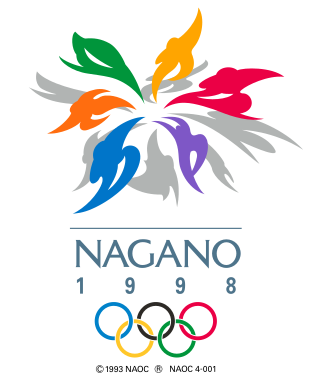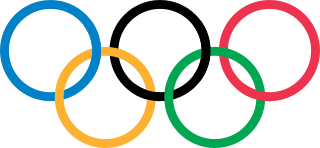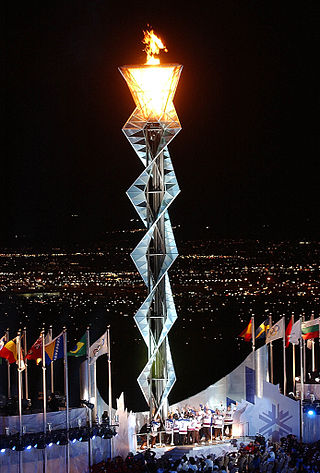
The 1998 Winter Olympics, officially known as the XVIII Olympic Winter Games and commonly known as Nagano 1998, was a winter multi-sport event held from 7 to 22 February 1998, mainly in Nagano, Nagano Prefecture, Japan, with some events taking place in the nearby mountain communities of Hakuba, Karuizawa, Nozawa Onsen, and Yamanouchi. The city of Nagano had previously been a candidate to host the 1940 Winter Olympics, as well as the 1972 Winter Olympics, but had been eliminated at the national level by Sapporo on both occasions.

Cyprus sent a delegation to compete at the 1998 Winter Olympics in Nagano, Japan from 7–22 February 1998. This was Cyprus' sixth appearance at a Winter Olympics. Their delegation to Nagano consisted of a single alpine skier, Andreas Vasili. In the men's slalom competition on the penultimate day of the games, he failed to finish his first run and was eliminated.

Portugal competed at the 1998 Winter Olympics in Nagano, Japan.
The Closing Ceremony of the 1996 Summer Olympics took place on August 4, 1996, at the Centennial Olympic Stadium in Atlanta, United States at approximately 8:00 PM EDT (UTC−4). It was produced by Don Mischer.

The Olympic Games ceremonies of the Ancient Olympic Games were an integral part of these Games; the modern Olympic games have opening, closing, and medal ceremonies. Some of the elements of the modern ceremonies date back to the Ancient Games from which the Modern Olympics draw their ancestry. An example of this is the prominence of Greece in both the opening and closing ceremonies. During the 2004 Games, the medal winners received a crown of olive branches, which was a direct reference to the Ancient Games, in which the victor's prize was an olive wreath. The various elements of the ceremonies are mandated by the Olympic Charter, and cannot be changed by the host nation. This requirement of seeking the approval of the International Olympic Committee (IOC) includes the artistic portion of opening and closing ceremonies.

The Closing Ceremony of the 1980 Summer Olympics was held at 19:00 Moscow Time (UTC+3) on 3 August 1980 at the Grand Arena of the Central Lenin Stadium. It was attended by the Chairman of the Presidium of the Supreme Soviet of the USSR, Leonid Brezhnev. IOC President Lord Killanin closed the Games for the final time and passed the position on to Juan Antonio Samaranch.
The closing ceremony of the 1994 Winter Olympics was held in Lysgårdsbakken in Lillehammer, Norway on 27 February 1994. All spectators were handed a flashlight with the inscription "Remember Sarajevo" – the host of the 1984 Winter Olympics which was at the heart of the Bosnian War. The first entrants on the stage were Liv Ullmann and Thor Heyerdal, followed by the athletes' precession. After the flag had been transferred to Nagano mayor Tasuku Tsukada, speeches were held by Lillehammer mayor Audun Tron, LOOC head Gerhard Heiberg and IOC president Juan Antonio Samaranch. The latter used his speech to commemorate Sarajevo's situation, before giving Heiberg the Olympic Order in gold, and declaring the games "the best Olympic Winter Games ever". Artistic presentations followed, revisiting many of the themes from the opening ceremony. The mascots of the 1998 Winter Olympics, the "Snowlets", were also presented. Of the 2,200 people performing in the opening and closing ceremonies, only 50 were professionals.
The opening ceremony of the 1996 Summer Olympics took place in the evening on Friday, July 19 at the Centennial Olympic Stadium, Atlanta, United States. As mandated by the Olympic Charter, the proceedings combined the formal and ceremonial opening of this international sporting event, including welcoming speeches, hoisting of the flags and the parade of athletes, with an artistic spectacle to showcase the host nation's culture and history. The Games were officially opened by President of the United States of America Bill Clinton.

The 2000 Summer Olympics Closing Ceremony was held on 1 October 2000 in Stadium Australia. As with the opening ceremony, the closing ceremony was directed by Ric Birch as Director of Ceremonies while David Atkins was the Artistic Director and Producer. The Closing Ceremony was attended by 114,714 people, the largest attendance in modern Olympic Games history. The ceremony celebrated Australiana; Australian cultural celebrities, icons, media, and music, with floats designed in the style of Reg Mombassa. Around 2.4 billion watched the telecast of the closing ceremony.

The closing ceremony of the 2014 Winter Olympics was held on 23 February 2014 from 20:14 to 22:25 MSK (UTC+4) at the Fisht Olympic Stadium in Sochi, Russia. It was designed to show Russian culture, through a European perspective, and featured performances by Yuri Bashmet, Valery Gergiev, Denis Matsuev, Hibla Gerzmava, and Tatiana Samouil, among others.
During the Parade of Nations section of the 1998 Winter Olympics opening ceremony, athletes from each country participating in the Olympics paraded in the arena. The flag from each team was borne by a sportsperson from that country chosen either by the National Olympic Committee or by the athletes themselves to represent their country. Due the rules stipulated by the Olympic Charter at the time the Organizing Committee opted for the option of the protocol order in English, instead of host nation's language, Japanese. Greece led the parade, followed by Andorra. Had the parade followed the Japanese characters, Greece would have been followed by Iceland, and Russian Federation would have been the penultimate country before Japan. One sumo wrestler and one yukiko which bears a country name sign marched before each delegation. Some of famous sumo wrestlers such as Takanonami and Wakanohana accompanied the teams. The yukikos also took part in several other segments in the ceremony.

The opening ceremony of the 2002 Winter Olympics took place at the Rice-Eccles Olympic Stadium in Salt Lake City, Utah, United States, on 8 February 2002.
The opening ceremony of the 1992 Summer Olympics took place on the evening of Saturday 25 July 1992 at Estadi Olímpic de Montjuïc, Barcelona, Spain, during which the Games were formally opened by King Juan Carlos I. As mandated by the Olympic Charter, the proceedings combined the formal and ceremonial opening of this international sporting event, including welcoming speeches, hoisting of the flags and the parade of athletes, with an artistic spectacle to showcase the host nation's culture and history.

The opening ceremony of the delayed 2020 Summer Olympics took place on 23 July 2021 at Olympic Stadium, Tokyo, and was formally opened by Emperor Naruhito. As mandated by the Olympic Charter, the proceedings combined the formal and ceremonial opening of this international sporting event, including welcoming speeches, hoisting of the flags and the parade of athletes, with an artistic spectacle to showcase the host nation's culture and history. The majority of the artistic spectacle was pre-recorded, with live segments performed adhering to social distancing to athletes, officials and a small VIP audience. The ceremony marked the 125th anniversary of the 1896 Summer Olympics in Athens—the inaugural edition of the modern Olympic Games.

The 1998 Winter Olympics torch relay was run from December 19, 1997 until February 7, 1998 prior to the 1998 Winter Olympics in Nagano. The route covered around 1,612 kilometres (1,002 mi) and involved over 6,916 torchbearers. Midori Ito lit the cauldron at the opening ceremony.
Tasuku Tsukada was a Japanese politician, and past mayor of the city of Nagano, the capital of Nagano Prefecture, in central Japan. Tsukada won his first mayoral contest in 1985. He served four full 4-year terms, until November 10, 2001. In 1997, Tsukada served as the Vice President of the Japan Association of City Mayors.

Nagano Sports Park is a park located in the Yoshida area of the city of Nagano, Nagano, Japan, approximately 5 km northeast of Nagano Station. The facilities are owned by Nagano Prefecture and by the Nagano municipal government.
Eishiro Saito was a Japanese businessman, the former President of Nippon Steel, the 6th Chairman of the Japan Business Federation (Keidanren) from 1986 to 1991, President of the Japan Science Foundation from 1988, President of the Japan Sports Fund, and President of the Nagano Olympic Organizing Committee.
The closing ceremony of the 1998 Winter Olympics took place at Nagano Olympic Stadium, Nagano, Japan, on 22 February 1998. It began at 18:00 JST and finished at approximately 19:41 JST. As mandated by the Olympic Charter, the proceedings combines the formal and ceremonial closing of this international sporting event, including farewell speeches and closing of the Games by IOC President Juan Antonio Samaranch. The Olympic flame has been extinguished.
The opening ceremony of the 1988 Winter Olympics was held on February 13, 1988, beginning at 1:30 p.m. MST at McMahon Stadium in Calgary, Alberta, Canada.











